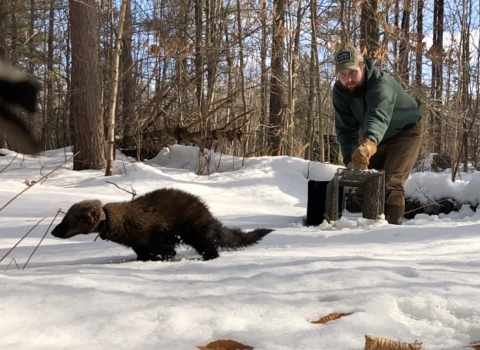Early this spring, federal biologists of the U.S. Fish and Wildlife Service and the National Biological Service combined satellite technology with 20/20 eyesight to solve one of the great biological mysteries of North America: Where do spectacled eiders, a rare and mysterious sea duck, go during the winter?
In late March, responding to a single location signal from a satellite transmitter attached to an eider hen, Fish and Wildlife biologists Bill Larned and Greg Balogh flew out over the frozen Bering Sea to visually search for an answer. To their amazement, they discovered tens of thousands of the elusive ducks jammed into tiny holes in the Bering Sea pack ice, which they kept unfrozen despite minus-20-degree (F) temperatures by their own remote warmth and movement.
Larned and Balogh returned to the remote location in early April to document 140,000 spectacled eiders, which biologists estimate to be at least half the total worlds population.
"This was the last waterfowl species in North America whose winter range was almost completely unknown," said Larned. Some had hypothesized that they dispersed on the open water near the sea ice during the winter, he said. "Finally finding these birds, this concentrated and inside the ice pack, is the most important and exciting find of my 20-year career. Its incredible.
"The density of the flocks was unprecedented," said Balogh. "It looked like every eider was touching six others. One flock flushed as we passed, and when they flew, a thick cloud of steam rose off the water surface and into the icy air."
A major component of the studies has entailed satellite-tracking technology Margaret Petersen, of the National Biological Service, headed a study team which fitted tiny transmitters to 22 spectacled eiders they captured on the Yukon-Kuskokwim Delta National Wildlife Refuge, Alaska, between May 16 and June 1, 1994. The transmitters gave the birds locations and body temperatures, to indicate whether the bird was alive.
The satellite picked up locations of the ducks through December 1994, when the batteries became too weak to send signals strong enough for tracking. Not surprisingly, the birds at that time were dispersed in the Bering Sea south of Saint Lawrence Island, where the sea ice had not yet frozen solid, according to Petersen.
Unexpectedly, in February, one location was obtained from a single transmitter fitted to a spectacled eider hen whose transmitter had been inactive since August. Strangely, the signal came not from an area of known open water, but from an area believed to be about 200 miles inside the ice pack and 100 miles off the Alaska coast. Based on that single location, Larned and Balogh used a chartered aircraft to search the area using aerial survey techniques. Their discovery of the spectacled eider wintering area solves a riddle that has puzzled scientists for decades.
The colorful duck, which sports a distinctive white eye patch circled by a black ring to give the look of spectacles, was listed as "Threatened" under the Endangered Species Act (Act) in 1993 after their western Alaska populations declined more than 90 percent in the last 30 years. No one knows the cause for the decline, but they are known to spend summers and breed in tundra areas of coastal Alaska. More than 90 percent of the worlds population is believed to breed in the Russian arctic.
Funding made available through the Act enabled formation of the interagency Spectacled Eider Recovery Team. Gathering existing data and initiating additional activities such as these survey flights, the team is working to determine the cause of the birds decline and how to assist its recovery.
"This discovery is a major step toward understanding how these birds live, what problems they may be facing, and other important questions we have about the Bering Sea ecosystem," said Fish and Wildlife Service biologist Russ Oates, the Recovery Team leader. "Now we have a starting point for planning the next phases of the recovery effort."


